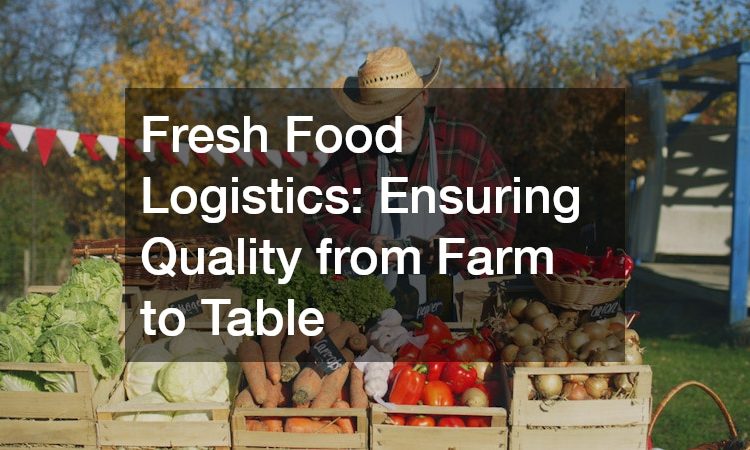
In today’s global food system, the journey from farm to table is critical to ensure that fresh produce maintains its quality and safety. This article explores the logistics involved in transporting fresh food, addressing key questions and concerns related to this complex process. From temperature control to regulatory compliance, each step in the logistics chain plays a vital role in preserving the integrity of fresh food.
Importance of Cold Chain Management
The significance of maintaining a consistent cold chain cannot be overstated in fresh food logistics. Cold chain management plays a crucial role in preventing spoilage and extending the shelf life of perishable goods.
Studies show that even a small deviation from the required temperature can expedite the deterioration of fresh produce, leading to increased waste and financial losses.
Effective cold chain management ensures that fresh food retains its nutritional value and quality until it reaches consumers. By implementing robust systems to monitor and control temperature, stakeholders can minimize the risk of compromising food safety. The global food industry heavily relies on these systems to meet consumer expectations and maintain business profitability.
Technology Solutions for Temperature Monitoring
The advent of IoT devices has revolutionized temperature monitoring in fresh food logistics. These advanced sensors continuously track environmental conditions, alerting logistics providers to any anomalies that could endanger product quality. Data analytics further enhances this process by providing insights into temperature trends and helping predict potential disruptions.
Temperature monitoring technologies enable real-time tracking, allowing swift actions to rectify any issues detected. With precise data at their fingertips, logistics managers can make informed decisions to protect the quality of fresh produce. This proactive approach reduces spoilage, ensuring that food arrives fresh and safe for consumption.
Efficient Route Planning
Route planning plays a pivotal role in reducing food waste in fresh food logistics. Optimizing delivery routes minimizes transit time, ensuring that perishable goods reach their destinations promptly. By analyzing traffic patterns and weather conditions, logistics managers can devise efficient routes that safeguard product quality.
Advanced route optimization tools leverage GPS and real-time data to identify the fastest, most reliable paths. This technology helps companies avoid delays that compromise the freshness of produce. Through strategic planning, transportation costs are reduced while maximizing the likelihood that fresh food maintains its intended quality upon delivery.
Packaging Innovations
Innovative packaging technologies have become essential in extending the shelf life of fresh produce. Materials that provide enhanced protection against temperature fluctuations and contamination are integral to preserving quality. For instance, vacuum-sealed packaging minimizes exposure to air, significantly delaying spoilage.
Biodegradable packaging solutions are also gaining popularity, balancing sustainability with product preservation. These materials reduce environmental impact without compromising the protective qualities necessary for fresh food logistics. Advanced packaging designs are engineered to offer superior barrier properties, reducing spoilage during transit.
Collaboration Across the Supply Chain
Effective collaboration among supply chain partners is crucial in reducing food waste during logistics operations. By communicating proactively, stakeholders can coordinate efforts to minimize delays, share resources, and harmonize operations. Strong partnerships enhance the visibility and efficiency of the supply chain, ensuring timely delivery of fresh produce.
Regular communication and shared transparency allow companies to anticipate and react to potential disruptions that could lead to spoilage. For instance, if a delay is anticipated, partners can make alternative arrangements to maintain product freshness. Collaboration fosters a culture of accountability and continuous improvement throughout the logistics process.
Compliance with Food Safety Standards
Food safety standards worldwide govern the transportation and handling of perishable goods to ensure consumer well-being. These regulations mandate stringent processes to maintain the integrity of fresh produce throughout its journey from farm to table. Compliance with these standards is crucial, as failing to do so can lead to severe penalties and damage to brand reputation.
Regular audits and inspections are conducted by regulatory bodies to evaluate adherence to safety standards. Logistics providers must ensure compliance with protocols, including appropriate temperature control and hygiene practices, to avoid foodborne illnesses. Adhering to these standards builds consumer trust and reflects a commitment to delivering safe, high-quality products.
International Trade and Logistics Regulations
International trade regulations significantly impact the movement of fresh food across borders. These laws address the complexities of cross-border logistics, requiring adherence to various documentation and compliance procedures. Navigating these regulations can be challenging, as they vary by region and often change in response to global trade dynamics.
Efficient management of international logistics involves understanding and fulfilling requirements such as customs documentation, tariff classifications, and trade agreements. Companies engaged in global trade must continually monitor these regulations to ensure seamless operations. Failure to comply with international trade laws can lead to delays, fines, and disruptions in the supply chain.
The intricacies of fresh food logistics require careful attention to temperature control, innovative strategies to reduce waste, and strict adherence to regulatory standards. By overcoming these challenges, the industry can ensure that fresh produce remains of high quality from farm to table. Continued collaboration, technological advancement, and compliance with evolving regulations will drive the success of fresh food logistics in delivering safe and nutritious food to consumers globally.
.

